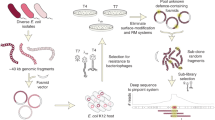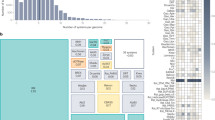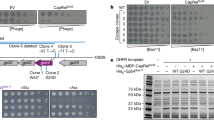Abstract
The evolutionary arms race between bacteria and phages has given rise to elaborate anti-phage defence mechanisms. Although many of these systems have been characterized at the molecular level, the general principles and constraints at play are underexplored. It is broadly recognized that in addition to the protection they provide, these systems also bear a substantial cost. Here we identify an expression-dependent trade-off between the protection range of defence systems and the fitness burden they impose. We first focus on the SpbK system of Bacillus subtilis and then generalize to other systems across a range of bacteria. We show that increasing expression of defence systems enhances their protection range, and provide evidence that this is achieved by overwhelming phage strategies for circumventing bacterial defence. However, for most systems tested, increased expression also leads to self-inflicted toxicity. This trade-off between protection and autoimmunity may shape the evolution of regulatory strategies and favour the coexistence of multiple systems within a single genome.
This is a preview of subscription content, access via your institution
Access options
Access Nature and 54 other Nature Portfolio journals
Get Nature+, our best-value online-access subscription
$32.99 / 30 days
cancel any time
Subscribe to this journal
Receive 12 digital issues and online access to articles
$119.00 per year
only $9.92 per issue
Buy this article
- Purchase on SpringerLink
- Instant access to full article PDF
Prices may be subject to local taxes which are calculated during checkout




Similar content being viewed by others
Data availability
All data supporting the findings of this study are available within the paper and its Supplementary Information.
Code availability
Code used to generate all figures is provided in the supplementary files.
References
Tesson, F. et al. Systematic and quantitative view of the antiviral arsenal of prokaryotes. Nat. Commun. 13, 2561 (2022).
Doron, S. et al. Systematic discovery of antiphage defense systems in the microbial pangenome. Science 359, eaar4120 (2018).
Bernheim, A. & Sorek, R. The pan-immune system of bacteria: antiviral defence as a community resource. Nat. Rev. Microbiol. 18, 113–119 (2020).
Ofir, G. et al. DISARM is a widespread bacterial defence system with broad anti-phage activities. Nat. Microbiol. 3, 90–98 (2018).
Gao, L. A. et al. Prokaryotic innate immunity through pattern recognition of conserved viral proteins. Science 377, eabm4096 (2022).
Adler, B. A. et al. Broad-spectrum CRISPR-Cas13a enables efficient phage genome editing. Nat. Microbiol. 7, 1967–1979 (2022).
LeRoux, M. et al. The DarTG toxin–antitoxin system provides phage defence by ADP-ribosylating viral DNA. Nat. Microbiol. 7, 1028–1040 (2022).
Johnson, C. M., Harden, M. M. & Grossman, A. D. Interactions between mobile genetic elements: an anti-phage gene in an integrative and conjugative element protects host cells from predation by a temperate bacteriophage. PLoS Genet. 18, e1010065 (2022).
Zhang, T. et al. Direct activation of a bacterial innate immune system by a viral capsid protein. Nature 612, 132–140 (2022).
Béchon, N. et al. Diversification of molecular pattern recognition in bacterial NLR-like proteins. Nat. Commun. 15, 9860 (2024).
Bobonis, J. et al. Bacterial retrons encode phage-defending tripartite toxin–antitoxin systems. Nature 609, 144–150 (2022).
Landsberger, M. et al. Anti-CRISPR phages cooperate to overcome CRISPR-Cas immunity. Cell 174, 908–916.e12 (2018).
Borges, A. L. et al. Bacteriophage cooperation suppresses CRISPR-Cas3 and Cas9 immunity. Cell 174, 917–925.e10 (2018).
Srikant, S., Guegler, C. K. & Laub, M. T. The evolution of a counter-defense mechanism in a virus constrains its host range. eLife 11, e79549 (2022).
Stokar-Avihail, A. et al. Discovery of phage determinants that confer sensitivity to bacterial immune systems. Cell 186, 1863–1876.e16 (2023).
Samuel, B., Mittelman, K., Croitoru, S. Y., Ben Haim, M. & Burstein, D. Diverse anti-defence systems are encoded in the leading region of plasmids. Nature 635, 186–192 (2024).
Yirmiya, E. et al. Phages overcome bacterial immunity via diverse anti-defence proteins. Nature 625, 352–359 (2024).
Tesson, F. et al. Exploring the diversity of anti-defense systems across prokaryotes, phages and mobile genetic elements. Nucleic Acids Res. 53, gkae1171 (2025).
Benzer, S. Fine structure of a genetic region in bacteriophage. Proc. Natl Acad. Sci. USA 41, 344–354 (1955).
Koonin, E. V. & Makarova, K. S. Anti-CRISPRs on the march. Science 362, 156–157 (2018).
Iranzo, J., Lobkovsky, A. E., Wolf, Y. I. & Koonin, E. V. Immunity, suicide or both? Ecological determinants for the combined evolution of anti-pathogen defense systems. BMC Evol. Biol. 15, 43 (2015).
Koonin, E. V., Makarova, K. S., Wolf, Y. I. & Krupovic, M. Evolutionary entanglement of mobile genetic elements and host defence systems: guns for hire. Nat. Rev. Genet. 21, 119–131 (2020).
Refardt, D., Bergmiller, T. & Kümmerli, R. Altruism can evolve when relatedness is low: evidence from bacteria committing suicide upon phage infection. Proc. R. Soc. B 280, 20123035 (2013).
Berngruber, T. W., Lion, S. & Gandon, S. Evolution of suicide as a defence strategy against pathogens in a spatially structured environment. Ecol. Lett. 16, 446–453 (2013).
Pleška, M. et al. Bacterial autoimmunity due to a restriction-modification system. Curr. Biol. 26, 404–409 (2016).
Severin, G. B. et al. Activation of a Vibrio cholerae CBASS anti-phage system by quorum sensing and folate depletion. mBio 14, e0087523 (2023).
Patterson, A. G. et al. Quorum sensing controls adaptive immunity through the regulation of multiple CRISPR-Cas systems. Mol. Cell 64, 1102–1108 (2016).
Høyland-Kroghsbo, N. M. et al. Quorum sensing controls the Pseudomonas aeruginosa CRISPR-Cas adaptive immune system. Proc. Natl Acad. Sci. USA 114, 131–135 (2017).
Quax, T. E. F. et al. Massive activation of archaeal defense genes during viral infection. J. Virol. 87, 8419–8428 (2013).
DeLong, J. P. et al. Towards an integrative view of virus phenotypes. Nat. Rev. Microbiol. 20, 83–94 (2022).
Agari, Y. et al. Transcription profile of Thermus thermophilus CRISPR systems after phage infection. J. Mol. Biol. 395, 270–281 (2010).
Fusco, S. et al. Transcriptome analysis of Sulfolobus solfataricus infected with two related fuselloviruses reveals novel insights into the regulation of CRISPR-Cas system. Biochimie 118, 322–332 (2015).
Westra, E. R. et al. Parasite exposure drives selective evolution of constitutive versus inducible defense. Curr. Biol. 25, 1043–1049 (2015).
Workman, R. E. et al. Anti-CRISPR proteins trigger a burst of CRISPR-Cas9 expression that enhances phage defense. Cell Rep. 43, 113849 (2024).
Loyo, C. L. & Grossman, A. D. A phage-encoded counter-defense inhibits an NAD-degrading anti-phage defense system. PLoS Genet. https://doi.org/10.1371/journal.pgen.1011551 (2025).
Weiner, M. P. & Zahler, S. A. Genome homology and host range of some SPβ-related bacteriophages of Bacillus subtilis and Bacillus amyloliquefaciens. J. Gen. Virol. 69, 1307–1315 (1988).
Kohm, K. & Hertel, R. The life cycle of SPβ and related phages. Arch. Virol. 166, 2119–2130 (2021).
Noyer-Weidner, M., Jentsch, S., Pawlek, B., Günthert, U. & Trautner, T. A. Restriction and modification in Bacillus subtilis: DNA methylation potential of the related bacteriophages Z, SPR, SP beta, phi 3T, and rho 11. J. Virol. 46, 446–453 (1983).
Kohm, K. et al. Structural and functional characterization of MrpR, the master repressor of the Bacillus subtilis prophage SPβ. Nucleic Acids Res. 51, 9452–9474 (2023).
Brady, A. et al. The arbitrium system controls prophage induction. Curr. Biol. 31, 5037–5045.e3 (2021).
Warner, F. D., Kitos, G. A., Romano, M. P. & Hemphill, H. E. Characterization of SPβ: a temperate bacteriophage from Bacillus subtilis 168M. Can. J. Microbiol. 23, 45–51 (1977).
Dedeo, C. L., Cingolani, G. & Teschke, C. M. Portal protein: the orchestrator of capsid assembly for the dsDNA tailed bacteriophages and herpesviruses. Annu. Rev. Virol. 6, 141–160 (2019).
Simpson, A. A. et al. Structure determination of the head–tail connector of bacteriophage φ29. Acta Crystallogr. D 57, 1260–1269 (2001).
Simpson, A. A. et al. Structure of the bacteriophage φ29 DNA packaging motor. Nature 408, 745–750 (2000).
Guasch, A. et al. Detailed architecture of a DNA translocating machine: the high-resolution structure of the bacteriophage φ29 connector particle. J. Mol. Biol. 315, 663–676 (2002).
Mahata, T. et al. Gamma-Mobile-Trio systems are mobile elements rich in bacterial defensive and offensive tools. Nat. Microbiol. https://doi.org/10.1038/s41564-024-01840-5 (2024).
Maffei, E. et al. Systematic exploration of Escherichia coli phage–host interactions with the BASEL phage collection. PLoS Biol. 19, e3001424 (2021).
Antine, S. P. et al. Structural basis of Gabija anti-phage defence and viral immune evasion. Nature 625, 360–365 (2024).
Garb, J. et al. Multiple phage resistance systems inhibit infection via SIR2-dependent NAD+ depletion. Nat. Microbiol. 7, 1849–1856 (2022).
Jaskólska, M., Adams, D. W. & Blokesch, M. Two defence systems eliminate plasmids from seventh pandemic Vibrio cholerae. Nature 604, 323–329 (2022).
Cheng, R. et al. A nucleotide-sensing endonuclease from the Gabija bacterial defense system. Nucleic Acids Res. 49, 5216–5229 (2021).
Li, Y. et al. PtuA and PtuB assemble into an inflammasome-like oligomer for anti-phage defense. Nat. Struct. Mol. Biol. 31, 413–423 (2024).
Li, Y. et al. Structure and activation mechanism of a Lamassu phage defence system. Preprint at bioRxiv https://doi.org/10.1101/2025.03.14.643221 (2025).
Lopatina, A., Tal, N. & Sorek, R. Abortive infection: bacterial suicide as an antiviral immune strategy. Annu. Rev. Virol. 7, 371–384 (2020).
Aframian, N. & Eldar, A. Abortive infection antiphage defense systems: separating mechanism and phenotype. Trends Microbiol. 31, 1003–1012 (2023).
Rousset, F. & Sorek, R. The evolutionary success of regulated cell death in bacterial immunity. Curr. Opin. Microbiol. 74, 102312 (2023).
van Houte, S., Buckling, A. & Westra, E. R. Evolutionary ecology of prokaryotic immune mechanisms. Microbiol. Mol. Biol. Rev. 80, 745–763 (2016).
Hussain, F. A. et al. Rapid evolutionary turnover of mobile genetic elements drives bacterial resistance to phages. Science 374, 488–492 (2021).
Wu, Y. et al. Bacterial defense systems exhibit synergistic anti-phage activity. Cell Host Microbe 32, 557–572.e6 (2024).
Harwood, C. R. & Cutting, S. M. (eds) Molecular Biological Methods for Bacillus (John Wiley, 1990).
Acknowledgements
We thank S. Pollak and J. Garb for fruitful discussions, and members of the Eldar lab for comments on the paper. We also thank T. Mahata, U. Qimron and D. Salomon for providing GAPS4 strains and for fruitful discussions. The Eldar lab is funded by European Research Council grant 101118890 and by Israel Science Foundation grant 2228/21. N.A. was supported by the Israeli Academy of Science’s Adams Fellowship.
Author information
Authors and Affiliations
Contributions
A.E. and N.A. designed the study. All experiments were performed by S.O.B unless indicated otherwise. S.O.B., T.H. and N.A. performed phage infection experiments. S.O.B. and P.G. performed RT–qPCR experiments. A.E. and N.A. wrote the paper. A.E. supervised the study.
Corresponding author
Ethics declarations
Competing interests
The authors declare no competing interests.
Peer review
Peer review information
Nature Microbiology thanks Edze Westra and the other, anonymous, reviewer(s) for their contribution to the peer review of this work.
Additional information
Publisher’s note Springer Nature remains neutral with regard to jurisdictional claims in published maps and institutional affiliations.
Extended data
Extended Data Fig. 1 Native and induced spbK relative expression levels.
(a) Relative transcript levels of spbK under different conditions, measured by RT-qPCR (methods). spbKICE is a strain harboring the full ICEBs1 element, and spbKwt a strain harboring spbK alone under its native promoter. Shown are means and error bars represent s.e.m. Points represents n = 3 biological repeats. (b) YFP expression under an IPTG-inducible promoter at different concentrations of IPTG. Shown are geometric means and s.e.m of the log. Individual points represent n = 3 biological repeats.
Extended Data Fig. 2 PFU/ml of different phages 2 hrs post infection of strains harboring spbK at different expression levels.
Shown are geometric means and s.e.m of the log. Individual points represent n = 3 biological repeats. * marks p < 0.05, ** marks p < 0.005, and *** marks p < 0.0005 (two-sided t-test).
Extended Data Fig. 3 Growth curves of bacterial strains expressing spbK at different expression levels, infected by different phages at MOI = 0.1.
Mean OD of n = 3 biological repeats and s.e.m (lighter shade) are shown.
Extended Data Fig. 4 Growth curves of cells coexpressing the natively expressed spbK gene and xylose-induced portal proteins of either phage SPO1 (gp3.3; left-hand side) or ϕ105 (gp04; right-hand side).
Mean OD of n = 3 biological repeats and s.e.m (lighter shade) are shown.
Extended Data Fig. 5 Growth curves of bacterial strains expressing Gabija at different expression levels, infected by different phages at MOI = 0.1.
Mean OD of n = 3 biological repeats and s.e.m (lighter shade) are shown.
Extended Data Fig. 6 Growth curves of bacterial strains expressing Lamassu at different expression levels, infected by different phages at MOI = 0.1.
Mean OD of n = 3 biological repeats and s.e.m (lighter shade) are shown.
Extended Data Fig. 7 Growth curves of bacterial strains expressing Septu at different expression levels, infected by different phages at MOI = 0.1.
Mean OD of n = 3 biological repeats and s.e.m (lighter shade) are shown.
Extended Data Fig. 8 PFU/ml of different phages 2 hrs post infection of strains harboring different system at different expression levels.
(a) Natively-expressed Lamassu shows weak but statistically significant effect against phages ϕ3T, ϕ3T-vir, and SPR. All strains were supplemented with 2% xylose. (b) Septu protects against SPO1 when overexpressed but not under native expression. Notice that protection against ϕ3T under native expression is only significant when applying a one-sided rather than two-sided t-test. All strains were supplemented with 50 μM IPTG. Shown are geometric means and s.e.m of the log. Individual points represent n = 3 biological repeats. * marks p < 0.05, and ** marks p < 0.005 (two-sided t-test).
Extended Data Fig. 9 Growth curves of E. coli bacterial strains expressing GAPS4 at different expression levels, infected by different phages at MOI = 0.1.
Mean OD of n = 3 biological repeats and s.e.m (lighter shade) are shown.
Extended Data Fig. 10 PFU/ml of EOP assays of different phages infecting strains expressing dsr2 at different levels.
Shown are geometric means and s.e.m of the log for phage SPR (a), an evading SPR-SPβ hybrid (b), a neutralizing SPR-SPβ hybrid (c) and phage SPβ (d). Individual points represent n = 3 biological repeats.
Supplementary information
Supplementary Information
Supplementary Figs. 1–4.
Supplementary Tables 1–3
1. Strain list. 2. Plasmid list. 3. Primer list.
Supplementary Data
Directory with data and code used to generate all figures, including all data files and code, as well as plate reader data.
Rights and permissions
Springer Nature or its licensor (e.g. a society or other partner) holds exclusive rights to this article under a publishing agreement with the author(s) or other rightsholder(s); author self-archiving of the accepted manuscript version of this article is solely governed by the terms of such publishing agreement and applicable law.
About this article
Cite this article
Aframian, N., Omer Bendori, S., Hen, T. et al. Expression level of anti-phage defence systems controls a trade-off between protection range and autoimmunity. Nat Microbiol 10, 1954–1962 (2025). https://doi.org/10.1038/s41564-025-02063-y
Received:
Accepted:
Published:
Issue date:
DOI: https://doi.org/10.1038/s41564-025-02063-y



